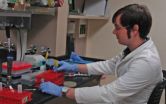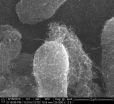Software helps synthetic biologists customize protein production
2011-07-22
(Press-News.org) A software program developed by a Penn State synthetic biologist could provide biotechnology companies with genetic plans to help them turn bacteria into molecular factories, capable of producing everything from biofuels to medicine.
"It's similar to how an engineer designs a plane or a car," said Howard M. Salis, assistant professor in agricultural and biological engineering, and chemical engineering. "When designing a biological organism, there are many combinations that the engineer must test to find the best combination. This technology allows us to quickly identify the best DNA sequence for a particular biotechnological application."
The program, called a DNA compiler, designs synthetic DNA sequences to control protein production inside simple organisms. Salis said narrowing down the exact genetic plans from the billions of possible sequence combinations will save biotechnology companies money and time.
To produce proteins, which are integral for creating and maintaining cells, an organism's DNA sequence controls the proteins that it makes and how much of each protein is produced.
DNA serves as a genetic template to create messenger RNA -- mRNA. Another form of RNA, transfer RNA, carries amino acids, the components of proteins, as ingredients for the proteins.
The software predicts how fast an organism will produce a specific protein. It can also design new DNA sequences to increase or decrease protein production across a large scale and to find the best protein production rates.
Salis, whose work appears in a recent issue of Methods in Enzymology, said that synthetic DNA sequences will play a more important role in industries as diverse as medicine and manufacturing. The biofuel industry is particularly interested in maximizing the amount of proteins produced to optimize metabolism. To be profitable, companies have to produce large quantities of biofuels.
"We're learning how to predict, control and design the behavior of biological organisms," said Salis. "We can do it much faster than evolution."
In one of the software's modes, genetic engineers can type strings of letters A, T, G and C that represent adenine, thymine, guanine and cystosine -- molecules in DNA-- into the software, which then calculates which protein will be made and how much protein will be produced, said Salis. In another mode, engineers select a protein's production rate inside the organism and the software optimizes a synthetic DNA sequence to achieve that rate.
###
Companies have obtained the licensed software to produce various chemicals, such as methyl ethyl ketone, a substance with numerous commercial and industrial uses, including inks, paints and industrial cements. A noncommercial version of the software, available on the web at http://salis.psu.edu/software/, designs over 300 sequences a month, Salis said.
The technology previously appeared in Nature Biotechnology. A Defense Advanced Research Projects Agency's young faculty award and the Penn State Institutes of Energy and Environment support this research.
ELSE PRESS RELEASES FROM THIS DATE:
Scavenger cells accomplices to viruses
2011-07-22
This release is available in German.
VIDEO:
Red-colored adenovirus particles are found in the periphery of a human epithelial cell and steadily move towards the cell nucleus at the bottom of the image. The endocytic vesicles in...
Click here for more information.
Mucosal epithelia do not have any receptors on the outer membrane for the absorption of viruses like hepatitis C, herpes, ...
Bacterial attack strategy uses special delivery of toxic proteins
2011-07-22
When competing for food and resources, bacteria employ elaborate strategies to keep rival cells at bay. Scientists have now identified a pathway that allows disease-causing bacteria to attack other bacterial cells by breaking down their cell wall.
Pseudomonas aeruginosa is a type of bacteria readily found in everyday environments. It easily forms colonies in a wide variety of settings, including medical devices, body organs and skin wounds. This allows it to cause disease and act as a major pathogen, particularly in hospitals.
Research led by Joseph Mougous, assistant ...
Blue collar workers work longer and in worse health than their white collar bosses
2011-07-22
While more Americans are working past age 65 by choice, a growing segment of the population must continue to work well into their sixties out of financial necessity. Research conducted by the Columbia University's Mailman School of Public Health and the University of Miami Miller School of Medicine looked at aging, social class and labor force participation rates to illustrate the challenges that lower income workers face in the global marketplace. The study used the burden of arthritis to examine these connections because 49 million U.S. adults have arthritis, and 21 ...
Chronic pain in homeless people not managed well: Study
2011-07-22
TORONTO, Ont., July 21, 2011—Chronic pain is not managed well in the general population and it's an even greater challenge for homeless people, according to new research by St. Michael's Hospital.
Twenty-five per cent of Canadians say they have continuous or intermittent chronic pain lasting six months or more. The number is likely to be even higher among homeless people, in part due to frequent injuries.
Of the 152 residents of homeless shelters with chronic pain studied by Dr. Stephen Hwang, more than one-third (37 per cent) had Chronic Pain Grade IV, the highest ...
Nanotechnology for water filter
2011-07-22
This release is available in German.
Nanotechnology has developed tremendously in the past decade and was able to create many new materials with a vast range of potential applications. Carbon nanotubes are an example of these new materials and consist of cylindrical molecules of carbon with diameters of a few nanometers – one nanometer is one millionth of a millimeter. Carbon nanotubes possess exceptional electronic, mechanical and chemical properties, for example they can be used to clean polluted water. Scientists of the University of Vienna had recently published ...
Fingerprinting fugitive dust
2011-07-22
This release is available in Spanish.
Each community of soil microbes has a unique fingerprint that can potentially be used to track soil back to its source, right down to whether it came from dust from a rural road or from a farm field, according to a U.S. Department of Agriculture (USDA) soil scientist.
Ann Kennedy, at the Agricultural Research Service (ARS) Land Management and Water Conservation Research Unit in Pullman, Wash., studies the biological properties of soils that affect wind erosion. She analyses the soil for the fatty acid or lipid content from the community ...
Study: Subsidizing wages at long-term care facilities would cut turnover
2011-07-22
CHAMPAIGN, Ill. — Subsidizing the wages of caregivers at group homes would likely reduce worker turnover rates and help contain costs at long-term care facilities, according to new University of Illinois research.
Elizabeth T. Powers, a professor of economics and faculty member of the Institute of Government and Public Affairs at Illinois, says that a government-sponsored wage-subsidy program could reduce the churn of low-wage caregivers through group homes by one-third.
"High rates of worker turnover have costs, and there aren't a lot incentives for the agencies that ...
Stronger social safety net leads to decrease in stress, childhood obesity
2011-07-22
CHAMPAIGN, Ill. — Social safety net programs that reduce psychosocial stressors for low-income families also ultimately lead to a reduction in childhood obesity, according to research by a University of Illinois economist who studies the efficacy of food assistance programs on public health.
Craig Gundersen, a professor of agricultural and consumer economics at Illinois, says food and exercise alone are not to blame for the extent of obesity among children in the United States. Psychosocial factors, such as stressors brought about by uncertainty about the economy, income ...
Executive pay reform unlikely to reduce systemic risk in economy
2011-07-22
CHAMPAIGN, Ill. — Reforms aimed at curbing executive compensation will likely have little effect on reducing systemic risk in the financial system, and they may even have unintended consequences for the freedom to contract, according to a University of Illinois expert in business law and corporate finance.
In a paper published in the Ohio State Entrepreneurial Business Law Journal, law professor Christine Hurt argues that giving regulators unprecedented power to prohibit certain types of private compensation under the guise of minimizing systemic risk in the financial ...
Study: Regulatory hurdles hinder biofuels market
2011-07-22
CHAMPAIGN, Ill. — Regulatory hurdles abound for the successful commercialization of emerging liquid biofuels, which hold the promise of enhancing U.S. energy security, reducing greenhouse gas emissions and serving as a driver for rural economic development, according to new U. of I. research.
In the study, University of Illinois law professor Jay P. Kesan and Timothy A. Slating, a regulatory associate with the University of Illinois Energy Biosciences Institute, argue that regulatory innovations are needed to keep pace with technological innovations in the biofuels industry.
"Getting ...





